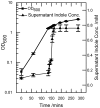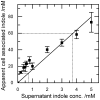The indole pulse: a new perspective on indole signalling in Escherichia coli
- PMID: 24695245
- PMCID: PMC3973702
- DOI: 10.1371/journal.pone.0093168
The indole pulse: a new perspective on indole signalling in Escherichia coli
Abstract
Indole has diverse signalling roles, including modulation of biofilm formation, virulence and stress responses. Changes are induced by indole concentrations of 0.5-1.0 mM, similar to those found in the supernatant of Escherichia coli stationary phase culture. Here we describe an alternative mode of indole signalling that promotes the survival of E. coli cells during long-term stationary phase. A mutant that has lost the ability to produce indole demonstrates reduced survival under these conditions. Significantly, the addition of 1 mM indole to the culture supernatant is insufficient to restore long-term survival to the mutant. We provide evidence that the pertinent signal in this case is not 1 mM indole in the culture supernatant but a transient pulse of intra-cellular indole at the transition from exponential growth to stationary phase. During this pulse the cell-associated indole reaches a maximum of approximately 60 mM. We argue that this is sufficient to inhibit growth and division by an ionophore-based mechanism and causes the cells to enter stationary phase before resources are exhausted. The unused resources are used to repair and maintain cells during the extended period of starvation.
Conflict of interest statement
Figures




References
-
- Lee JH, Lee J (2010) Indole as an intercellular signal in microbial communities. FEMS Microbiology Reviews 34: 426–444. - PubMed
-
- Chant EL, Summers DK (2007) Indole signalling contributes to the stable maintenance of Escherichia coli multicopy plasmids. Molecular Microbiology 63: 35–43. - PubMed
-
- Li G, Young KD (2013) Indole production by the tryptophanase TnaA in Escherichia coli is determined by the amount of exogenous tryptophan. Microbiology-Sgm 159: 402–410. - PubMed
Publication types
MeSH terms
Substances
Grants and funding
LinkOut - more resources
Full Text Sources
Other Literature Sources
Molecular Biology Databases

